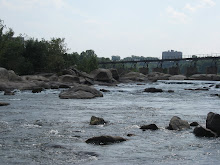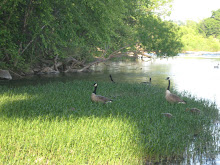Jack Gartside, a well known fly tier residing in Boston, states that fly tying is an activity in which your fingers and eyes take your imagination on an angling voyage when life prevents you from physically doing so (please forgive my paraphrasing). As you sift through mounds of feathers, furs and synthetics your mind immediately transforms these materials into an object- an object which may just be the ticket to a dream. As a new fly tyer it has become clear that there are five basic components (note I did not state guidelines or rules) to dwell on when fly tying.(1) PatternPattern as a heading is a bit a vague, but
rightfully so due to the numerous manifestations of sensory
input that fish associate with forage. Scientifically, this is know as the search image-patterns of sensory
input which animals translate into a feeding opportunity. In tying terms, pattern refers to the type of critter you are trying to imitate-
crustaceans like crayfish,
bait fish,
macroinvertabrates (i.e.
aquatic insects), terrestrials etc. These headings can be decomposed even further. For instance, are you imitating the larval, nymph or adult stage of aquatic insects? Are you going to tie
terrestrial insects or mammals including grass hoppers, cicadas and small rodents respectfully? The final pattern category may be the ugly Betty-those flies that simply catch the fish's attention through being big, colorful and
narly (a circus peanut comes to mind).
(2) Material PropertiesThis is often a frustrating one for
tyers as we face endless options of tying materials
available for purchase. This is apparent after your first trip to a fly shop, whether you visit one down the road or via
cyber space. The type of material you tie with may be straight forward if you are using recipes of well known flies; however, creative
tyers take note of a material's action and properties. Consider the following:
a. Does the material pulsate and flow in a fleshy manner, or is it stiff and rigid (think of the action rabbit and marabou relative to that of
EP fibers used for many
bait fish patterns)? This will greatly influence the
fly's profile.
b. Is the material
hydrophobic, that is, does it
repel water or absorb it like a sponge? This property will greatly impact the sink rate of a fly.
c. Related to item 'b', how
buoyant is the material? In addition to the degree of
hydrophobicity, a a
materials density can affect its
buoyancy.
d. How well does the material push or move water? The lateral line on a fish enables it to detect pressure due to displaced water, so patterns that incorporate materials that push water as they are stripped are often good attracting patterns. The
wool head on some articulated streams accomplishes this.
e. How well does the material reflect light?
(3) Color and SizeMany anglers who match the hatch can often be caught debating whether it is more important to match the color or size of particulate insects; this also undoubtedly applies to matching the
prevalent bait fish species, so even the
Striper folks are guilty! Two parameters dictate the color and size of a fly: (1) the forage being imitated and (2) current conditions. The extent to which fish are keying on particular prey items can influence how closely the color and size must be matched. Light availability is the main ingredient impacting how well fish see particular colors, and light availability is a function of depth, cloud cover, time of day and the water's silt and sediment load. When tying streamers I have found that
chartreuse, purple, olive and white are suitable for most situations.
(4) CastabilityThis item became ever so clear the first time I tried to cast a a 5 inch bunny leech with a 5wt rod using a small tippet...anyone who has ever sailed a fly through the air as their tippet snaps understands this. Consider how heavy (wet weight) and bulky (this impacts air resistance) the fly is, and how well your particular set up will handle this mass.
(5) There are no rules!
You can tie with any material, of any color, in any combination to your heart's content. Many
tyers get caught up, and often limited, when they think there are
strict guidelines and only a certain way to craft a particular fly. Going back to my opening statement, allow your imagination to wander...strive to build a pattern that you can call your own. Granted, the staples (e.g. C
lousers, deceivers, Elk Hair
Caddis) have their places and have proven their abilities like a seasoned veteran athlete. But, I am willing to bet that your rookies can out compete these guys if you give them the time and effort they deserve!


























































